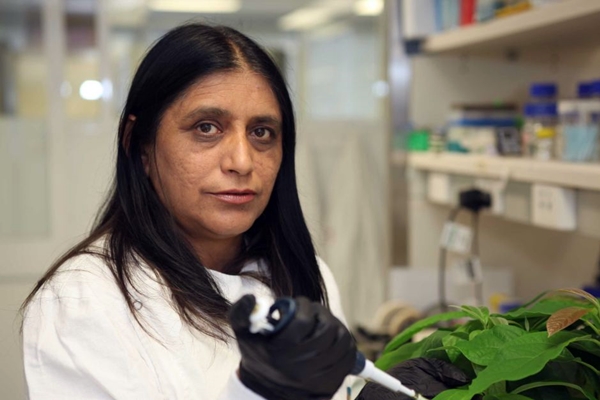12 January 2017. Plant scientists combined synthetic genetic material with clay nanoparticles, which when sprayed on plants provides enduring protection against viruses. Researchers from University of Queensland in Brisbane, Australia and University of Surrey in the U.K. describe the technology in the 9 January issue of the journal Nature Plants (paid subscription required).
The team led by Queensland agricultural biotechnologist Neena Mitter and University of Surrey chemical engineer and nanotechnologist G.Q. Max Lu — also the institution’s president and vice-chancellor — is seeking better techniques for protecting crops from pests and pathogens, among the greatest threats to food security worldwide. The authors cite data showing these threats reduce crop yields as much as 40 percent per year. Current methods using pesticides run environmental and public health risks, while introducing new genes to plants faces increasing consumer resistance.
Mitter, Lu, and colleagues adapted a biotechnology technique known as RNA interference, a natural process to silence the expression of genes associated with disease. RNA is genetic material related to DNA that the organism uses to transmit genetic information to cells and synthesize proteins. RNA interference can be achieved by adding a synthetic strand of RNA material to the normal single RNA strand, which then binds to the target proteins. The target proteins in this case stop the plant from responding to pathogens.
The synthetic double-stranded RNA molecules, however, are often too unstable and degrade quickly when applied to plant life, requiring a delivery method that protects the fragile molecules, yet is still practical and economical. The technique designed by the researchers uses nanoscale particles of double hydroxide clay, a non-toxic and degradable material tested for time-released delivery of drugs. Combining the synthetic RNA with clay nanoparticles makes it possible to spray a solution of the material, which the researchers call BioClay, on plants.
In lab tests, the team sprayed a solution of BioClay with double-stranded RNA on Arabidopsis plants, a common well-studied model species. The tests show BioClay delivers double-stranded RNA to the plants, which forms into a thin layer and releases into the plants for as long as 30 days. And while the layer of clay degrades and disappears, the double-stranded RNA remains in the plant, protecting against test viruses for at least 20 days. That protection extends to leaves that grow on the plant after the initial spraying.
“A single spray of BioClay protects the plant and then degrades, reducing the risk to the environment or human health,” says Mitter in a Queensland statement. “Once BioClay is applied, the plant ‘thinks’ it is being attacked by a disease or pest insect and responds by protecting itself from the targeted pest or disease.”
The study was conducted in partnership with Nufarm Ltd., an agricultural chemical and specialty seed company in Victoria, Australia.
Read more:
- U.S. Public Divided Over GM, Organic Food
- Seedless Fruit Varieties Seen As Food Security Boost
- Spinach Enhanced to Detect Chemicals, Send Signals
- Monsanto Licensing MIT/Harvard Genome Editing
- Genetic Techniques Quickly Build Crop Disease Resistance
* * *


 RSS - Posts
RSS - Posts
You must be logged in to post a comment.